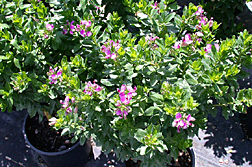This page has been archived and is being provided for reference purposes only. The page is no longer being updated, and therefore, links on the page may be invalid.
|
Read the magazine story to find out more. |
|
|
Colorful New Tropical Evergreen for U.S. Gardens
By Alfredo FloresJanuary 6, 2006
A showy South African evergreen known as cape milkwort could soon brighten southern U.S. gardens with vibrant masses of year-round purple blooms. Alan Meerow, a plant geneticist with the Agricultural Research Service (ARS), is responsible for bringing the plant to the United States for study.
When Meerow encountered the cape milkwort (Polygala myrtifolia) in South Africa in 1997, he soon envisioned it as a welcome addition to subtropical U.S. gardens.Its flowers form in small clusters of inch-long blossoms at the ends of short branches. Lower buds open first, to reveal showy purple petals beautifully marked with darker veins.
The plant flowers throughout the year, peaking in spring and summer with profuse blooms amidst bright-green, slightly glossy, oval leaves roughly two inches long by one-half inch wide. While the species can grow up to 12 feet high, this particular cape milkwort--called Chapman Field--only reaches four feet.
Meerow works at the ARS Subtropical Horticulture Research Station (SHRS) in Miami, Fla. The station's mission is the conservation and genetic characterization of valuable germplasm.
Seed of P. myrtifolia was purchased from a commercial seed company in South Africa that is licensed to collect native plants. After two years of trial and evaluation, the SHRS researchers selected one seedling with superior attributes. They named this particular variety Chapman Field in acknowledgment of work done over the years at SHRS, which is located on what used to be the U.S. Navy’s Chapman Airfield.
The seed population from which Chapman Field was selected originated in a climate very similar to south Florida’s, and the new variety stands apart because of its dense foliage, heavy flowering and quick growth--just two to three months to propagate.
Meerow worked closely with ARS horticulturalist Tomas Ayala-Silva to add P. myrtifolia to the National Plant Germplasm System collection and develop this promising evergreen ornamental for distribution to commercial growers.
Read more about the research in the January 2006 issue of Agricultural Research magazine.
ARS is the U.S. Department of Agriculture's chief scientific research agency.

